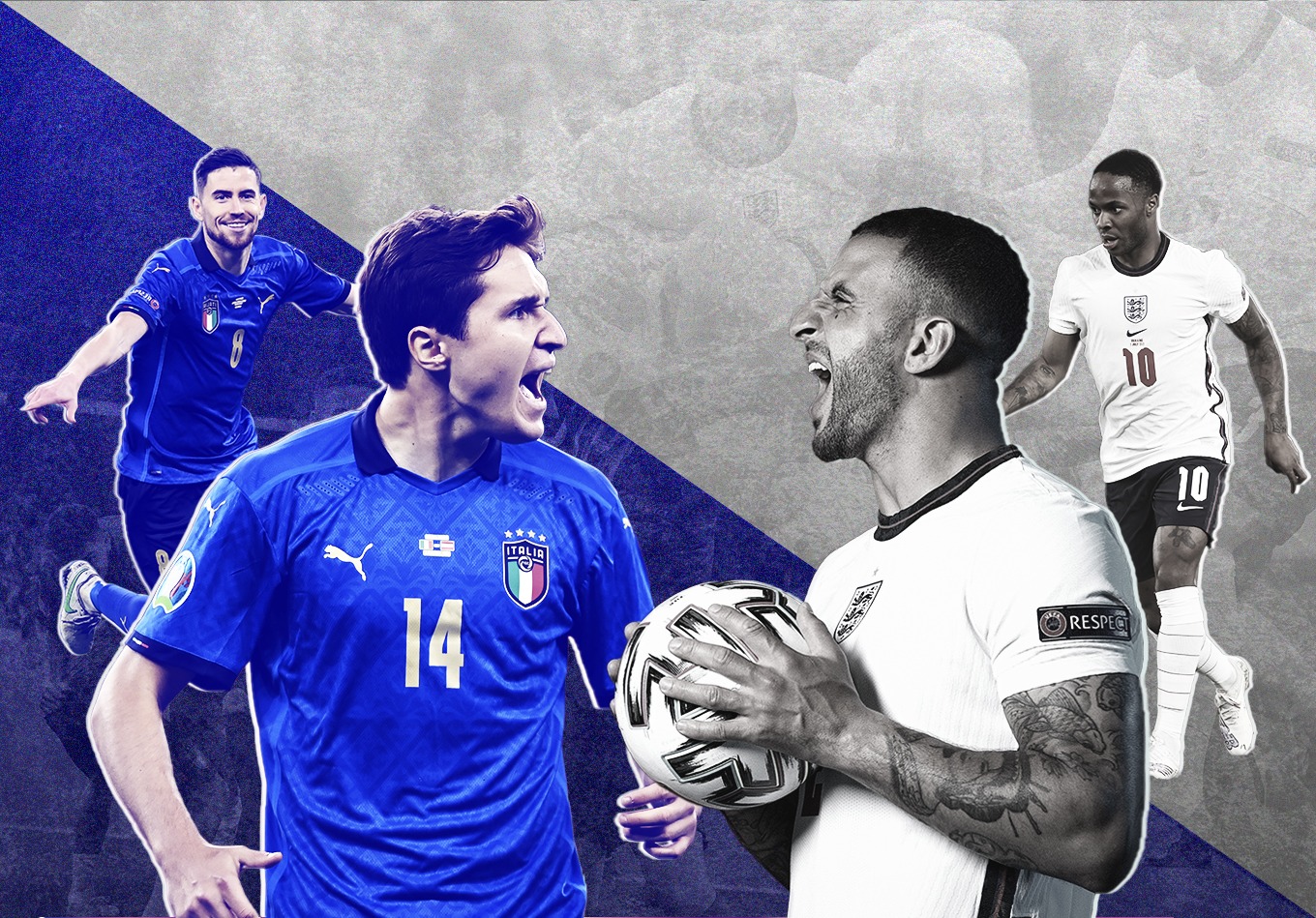The big one. It’s finally here. England’s men’s first major final appearance for 55 years. Italy’s first in *checks notes* nine years. Oh, is that all?
England’s record against Italy in major tournaments is not great, losing three of these four times they’ve met and going out infamously in Euro 2012 on penalties. (Cheers Pirlo).
But as we outlined here, this England generation are different. And there’s every chance they can re-write history on Sunday.
And it turns out there’s a lot they can learn from how Spain played Italy. Gareth will have been watching…
1. Italy could not deal with the Spanish press. Can England put the back four under pressure?
Up until their semi-final against Spain, Italy had enjoyed serene progress. One cagey initial 90 minutes against Austria aside, their Euro 2020 journey had been smooth. Four wins from five and a positive goal difference of nine. That was until they faced Spain who, let’s be honest, they struggled against. Spain were arguably the better side on the day and perhaps unfortunate not to progress.
What was extremely notable about this game though, was just how uncomfortable Italy were when pressed high by Spain.
It was not a new approach for La Roja – they’ve pressed high all tournament and their 8.1 PPDA, a useful proxy for pressing, is by far and aware the lowest of all teams. It was no different against the Azzurri and in fact, they went even more aggressive, hounding the Azzurri back line for the entirety of the match.
Italy averaged just two and a half passes per possession and held onto the ball for six seconds at a time on average against Spain, both comfortable tournament lows for them. For context, they averaged around 10 seconds per possession in each of their other four matches. Spain rushed and harried them so much that they managed a meek 74% pass completion rate – far below their tournament average of 86%.
This pressing had a particular impact on Italy’s two central defenders and goalkeeper who, unable to play through Spain’s press, were forced to go long. The indominable duo of Leonardo Bonucci (71%) and Giorgio Chiellini (83%), as well as ‘keeper Gianluigi Donnarumma (66%) had their poorest passing accuracy of any game in a major tournament and both Donnarumma and Chiellini played their highest proportion of long passes in a Euro 2020 match to date.
Looking at the pass maps from Chiellini and Bonucci below shows how much they were forced to go long.
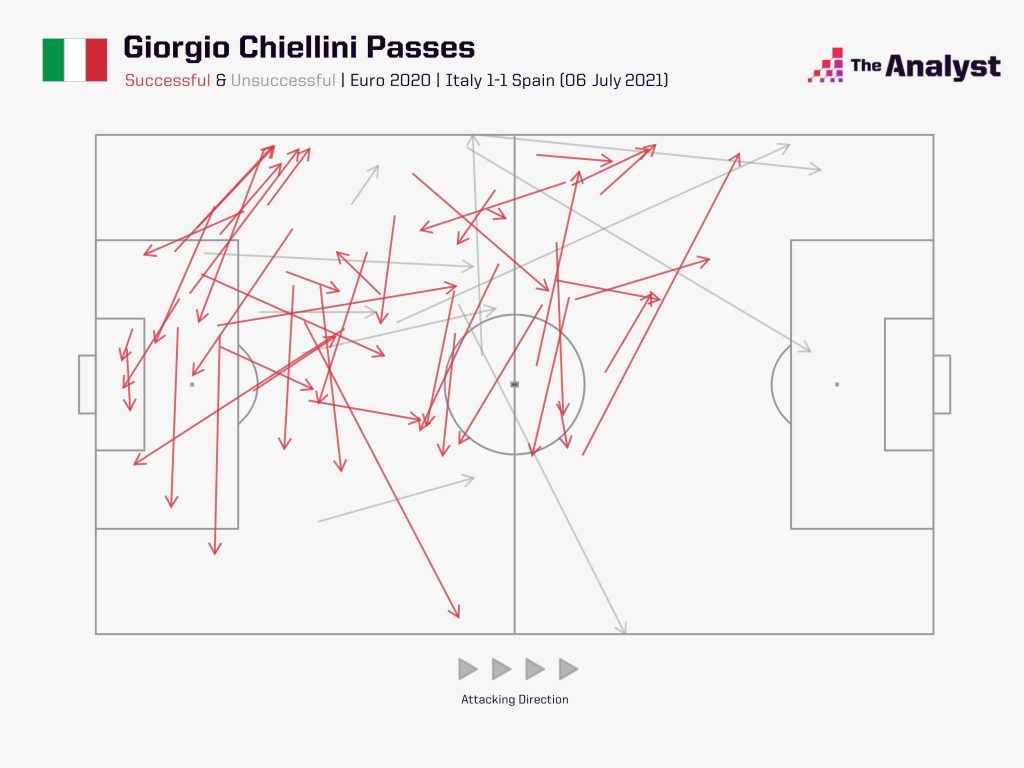
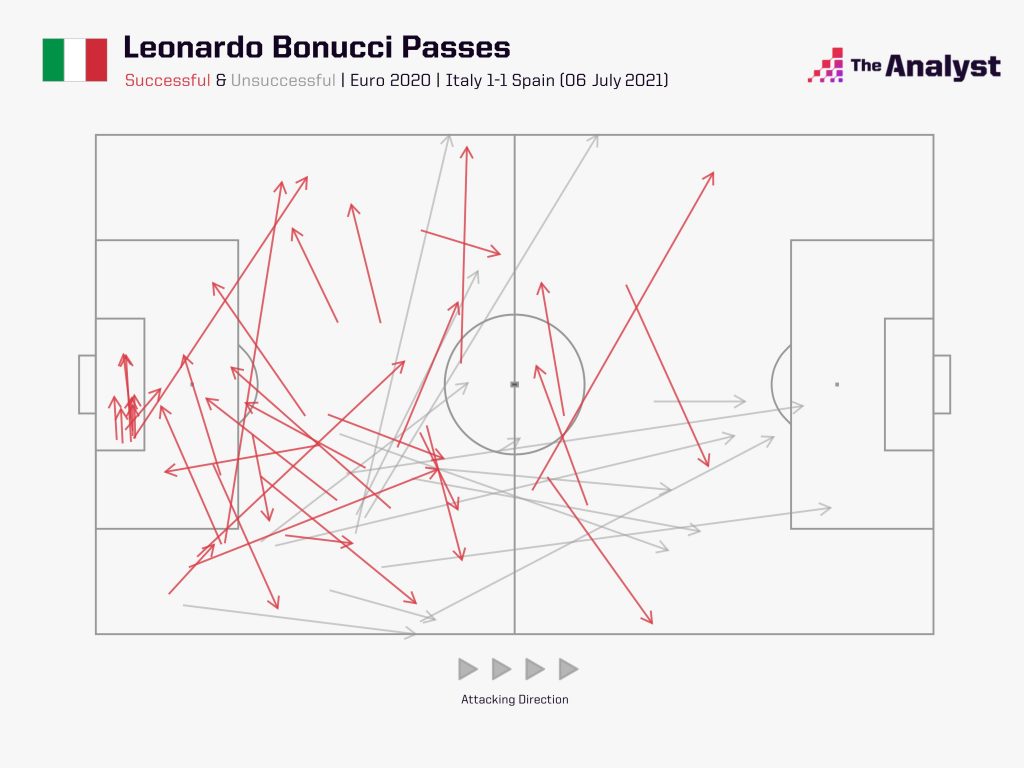
Italy saw their restarts from Donnarumma as an opportunity for them to get a foothold in the game and keep possession for a little longer in a match where they didn’t have much. Spain had the opposite idea.
We got to see a glimpse of Spain’s defensive set up really early in the game. Two minutes in and Bonucci is fouled in his defending third. On the restart, Bonucci plays short to Donnarumma and every Italian player in picture is tracked man for man by a Spanish defender.
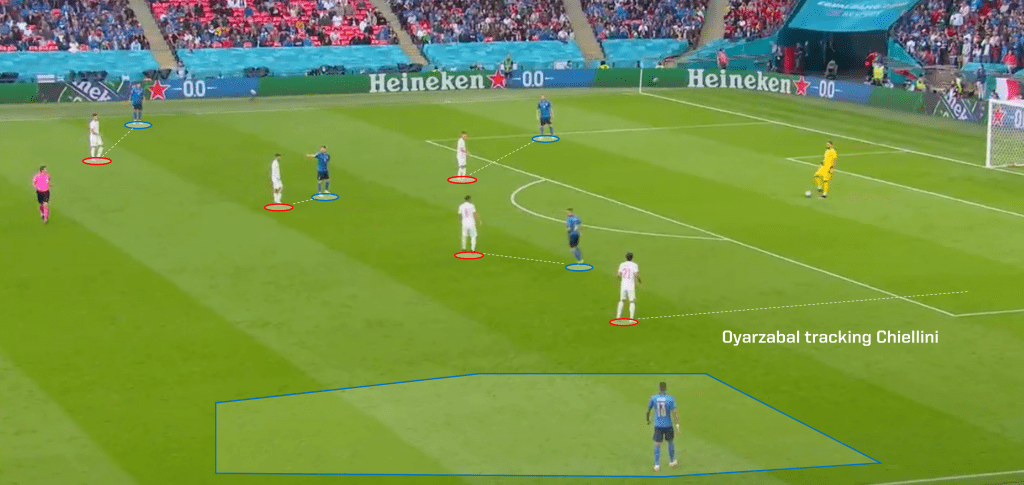
Below is the same scenario seen from a different angle, the picture that Donnarumma himself would see.
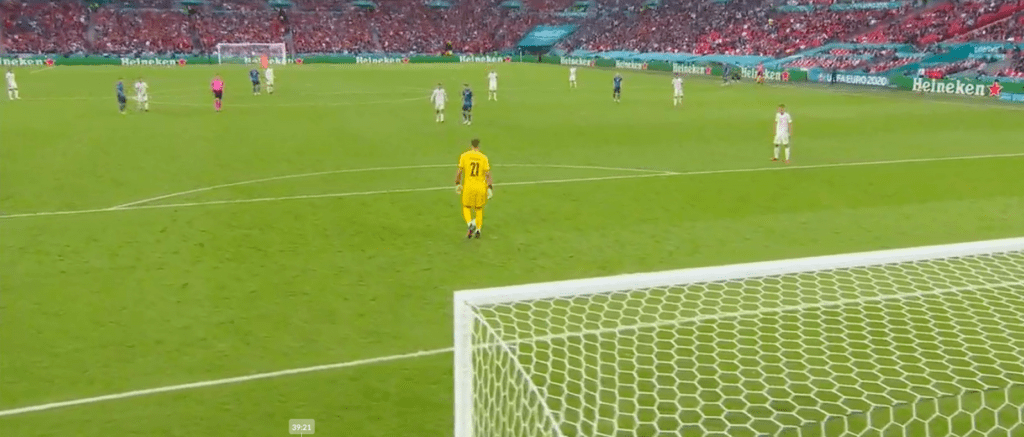
Spain pushed their entire team upfield, with the deepest player in the centre circle. They were set up with a heavier bias towards Italy’s right-hand side, covering the better ball-playing centre-back of the two: Bonucci. Donnarumma was being encouraged to play to Chiellini or to go over the top of the press to Emerson. Emerson isn’t being marked due to the distance the ball has to cover to get to him if Donnarumma was to attempt that option, Spain knew they could cover that ground quick enough to apply pressure.
Distrbution from Donnarumma’s hands
A different open-play situation that Italy faced often was where Donnarumma had collected a loose ball with his hands. Spain set themselves up similarly – high and tracking man to man in midfield.
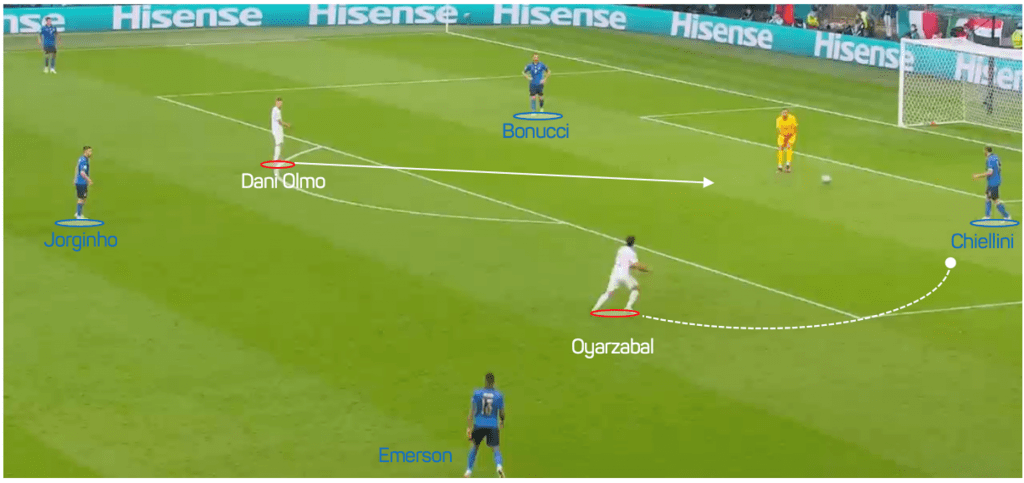
As Donnarumma begins to roll the ball from his hands to Chiellini, this is the trigger for both Mikel Oyarzabal and Dani Olmo to start their press. Oyarzabal approaches Chiellini with intensity, arcing his run to cut off the passing lane to Emerson, meaning that Chiellini has to come back inside, setting it back to Donnarumma.
During this time, Olmo advances towards Donnarumma as he anticipates that ball back inside, leaving Donnarumma no choice but to play it long and then Italy’s possession is lost.
However, this ‘weakness’ of Italy’s can also lead to shots on their opponents goal. A prime example in the game vs. Spain showed how they can go from back to front in a matter of seconds, and we know just how good Italy are when moving at speed.
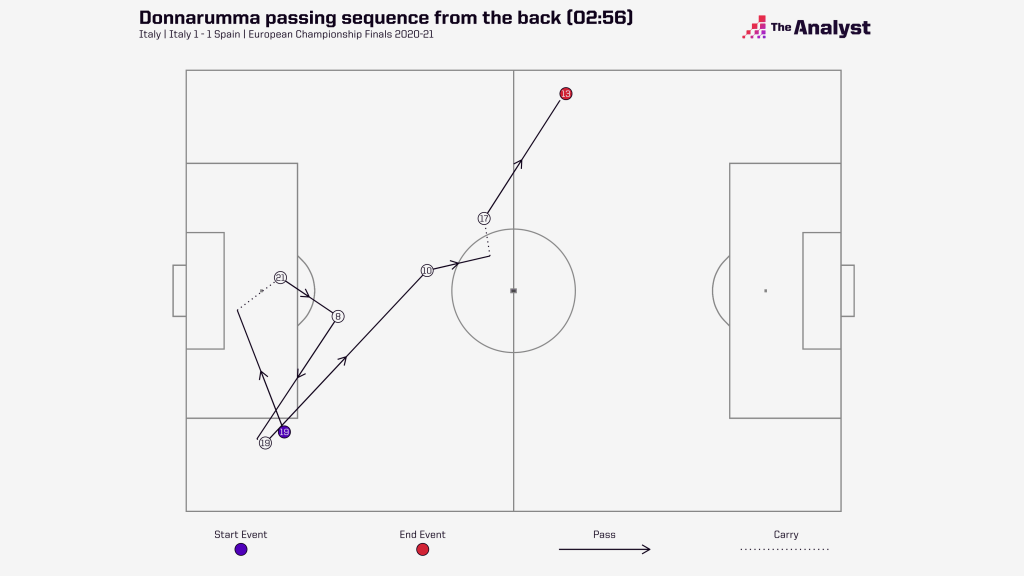
- Donnarumma plays short to Jorginho.
- Jorginho plays backwards to Bonucci, Jorginho & Verratti direct Bonucci to play back to Donnarumma, but instead he opts to play longer with a slightly lofted pass beyond Spain’s press to Insigne who drops short near the halfway line.
- Insigne cleverly flicks the ball on first time with his chest to Immobile who plays it to Emerson just inside Spain’s half, who plays a lovely ball in behind Spain’s defence to Barella who then goes on to hit the post. Unfortunately, this move was pulled back for offside.
Will England imitate Spain’s defensive setup? If they do, their traps will need to be set and executed to perfection.
2. England must block service into Jorginho
Jorginho is Italy’s metronome. He’s played more minutes than any outfield player for Roberto Mancini, and while talk of him being a genuine Ballon d’Or content seems tongue-in-cheek, there’s no doubting his influence on his national team.
Jorginho is clearly never going to top any charts for traditional metrics like goals and assists. After all he’s scored five goals for Italy and registered two assists in 34 games. And all five of those were penalties.
You probably know that given his role for the side he’s going to rank highly for possession metrics, like passes (the most for Italy in Euro 2020), pass completion (third-best) and touches (most). However, we can quantify the impact of those passes for Italy.
For starters, those passes contribute to shots for his side. Looking at his involvement in open-play sequences that end in a shot demonstrates Jorginho’s importance to launching attacks. Only two Spaniards, Pierre-Emile Højbjerg and teammates Lorenzo Insigne can match him here.
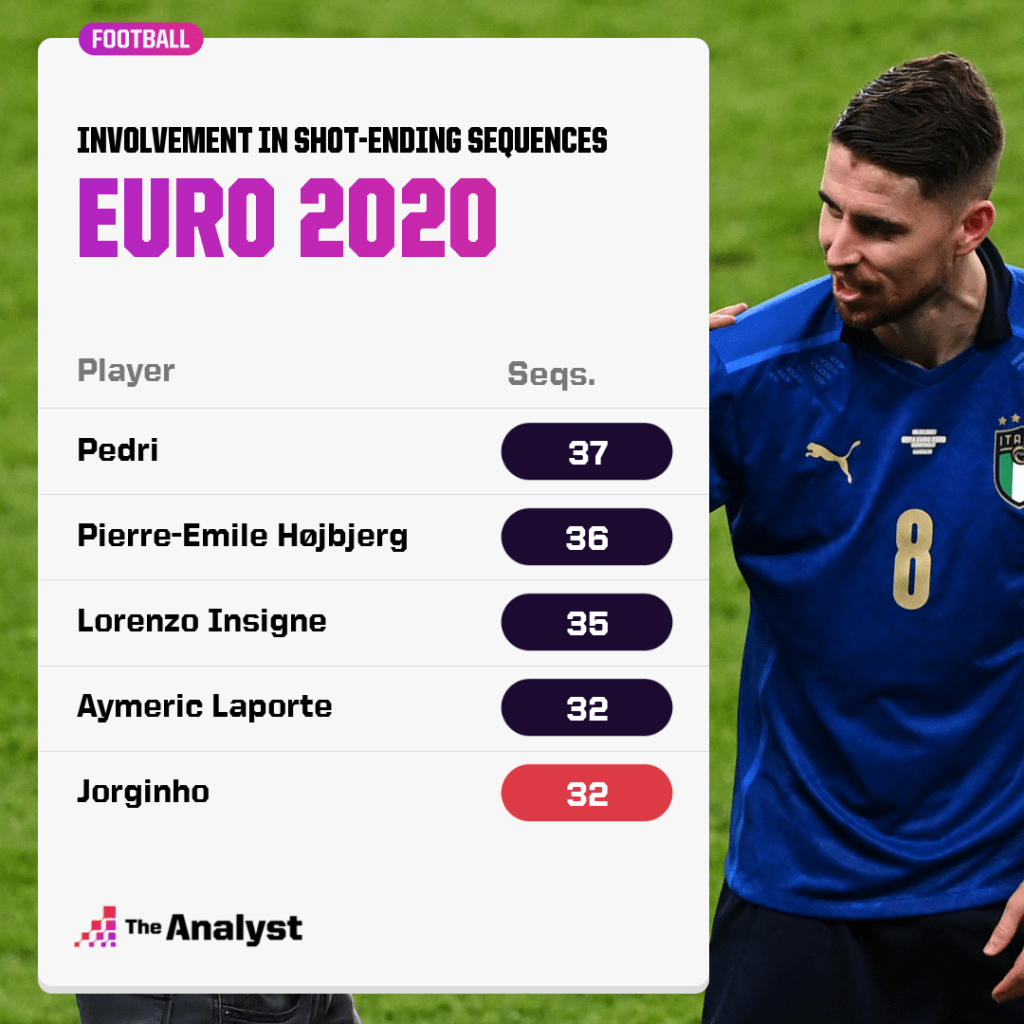
And only Insigne’s involvement in open-play is worth more in terms of generating xG for his side than Jorginho’s:
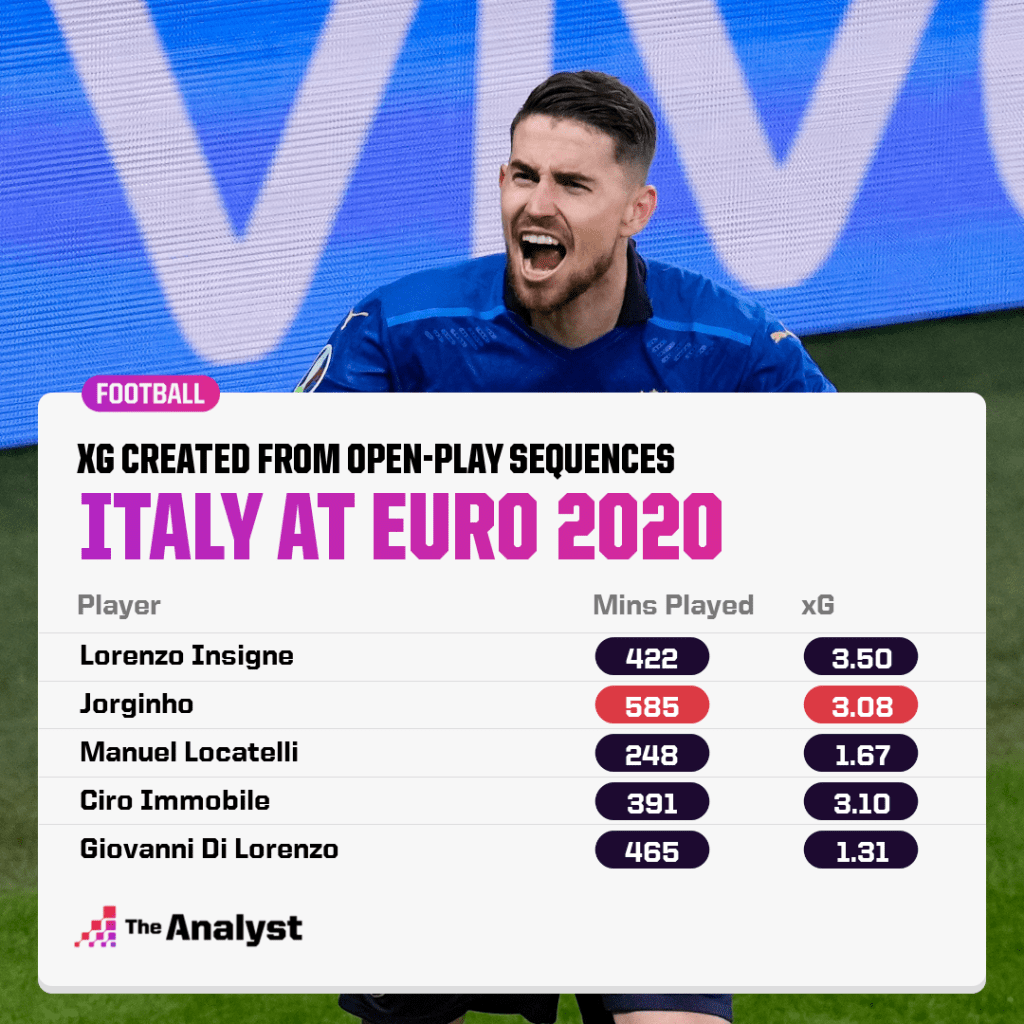
So, England will need to shut off the supply line to the maestro. Spain’s press, which we mentioned in the above point was mainly a man-to-man press, did a good job at this. They stuck someone on Jorginho at all times, forcing Italy’s centre-backs to bypass him.
Take this example from midway through the first half. Bonucci has the ball at his feet with his head up, looking for a pass. Pedri is tight to Jorginho. Marco Verratti comes short, opening up space in behind as Koke tracks his run.
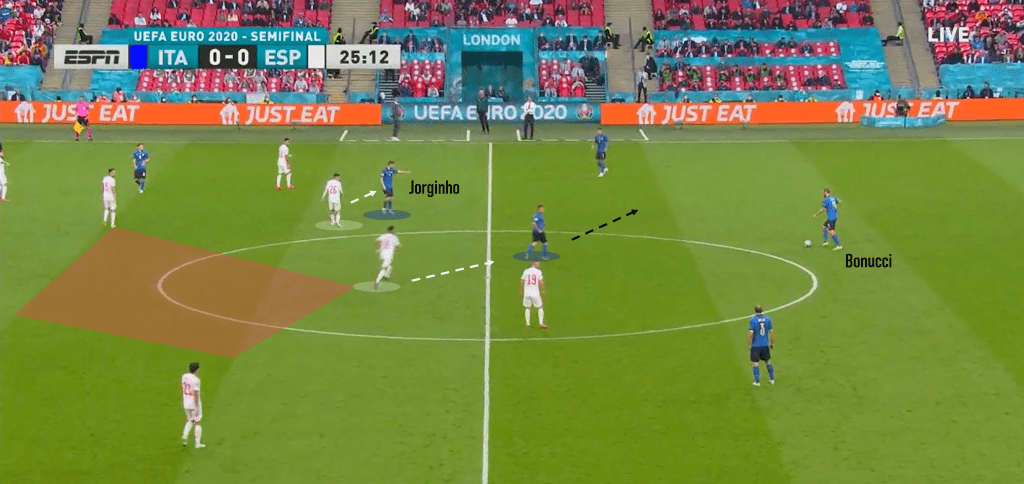
As Jorginho moves inside to try and find the space that Verratti vacated, Pedri sticks to him like glue, remove him as a passing option. In fact, the others in Spain’s temporary front four are also pressing their opposite numbers, with Olmo doing a nice job of blocking Bonucci’s passing lane to Chiellini while also pressuring the Juventus defender.
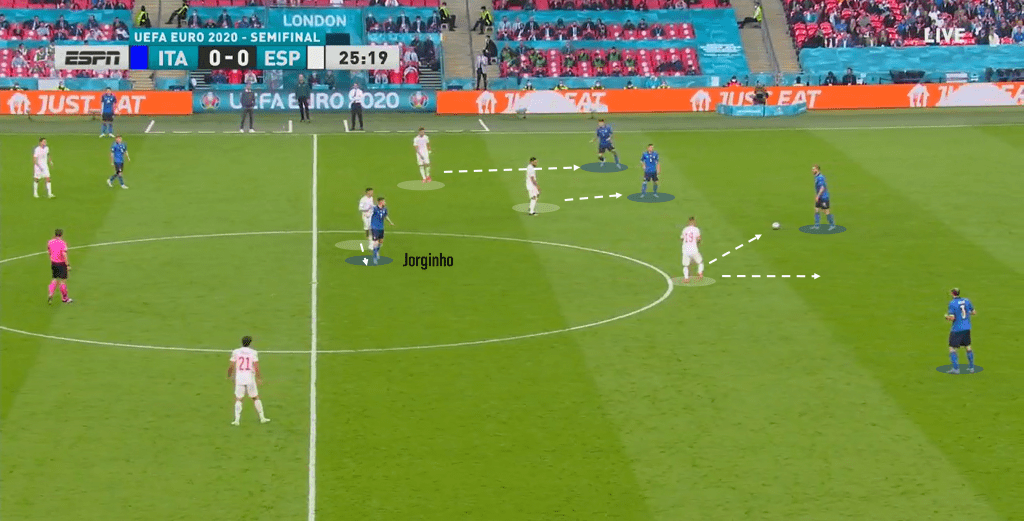
Bonucci has no option but to play it long and concedes possession.
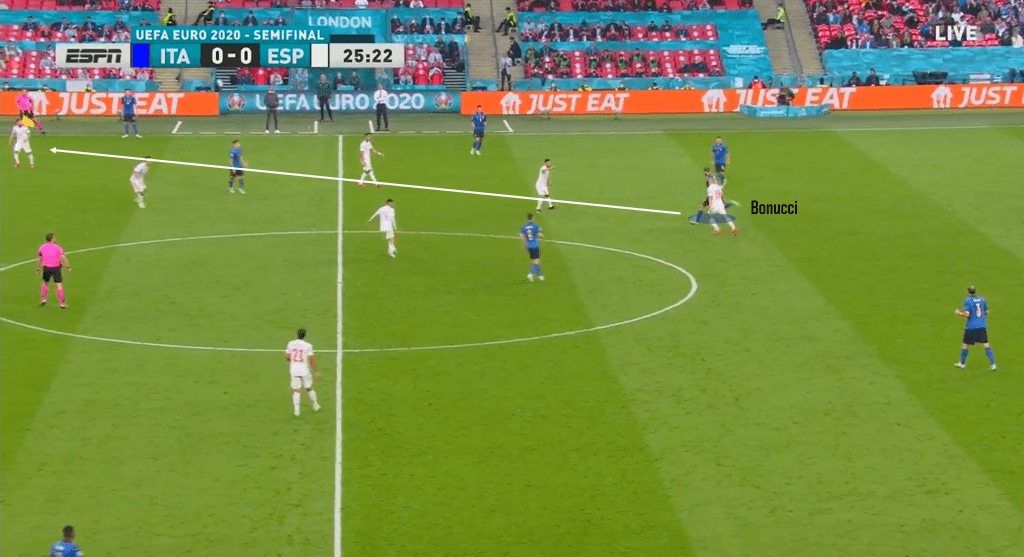
Italy’s success can largely be pointed towards their three-man midfield in which Jorginho sits the deepest. The other two players don’t just make up the numbers though, Nicolo Barella and Verratti have played a huge role in Italy’s path to the final.
Defensively England will need to adapt to match the Italian’s midfield three when out of possession. After being labelled as Frank Lampard’s golden boy, Mason Mount has also captured the hearts of England fans. If Southgate gives him the nod to start against the Italian’s, his role will be pivotal in tracking his Chelsea teammate when England are without the ball.
Mount is an intelligent young midfielder and has shown that he can consistently do the job his team requires of him. He will need to be disciplined as Jorginho covers a lot of ground and makes clever little movements to pull away from his marker. Mount will need to get tight and be aggressive, allowing him to dictate Jorginho’s decisions in possession. Spain’s system really hampered Jorginho’s ability to dictate the game in their semi-final. He attempted just 33 passes and touched the ball 50 times in 120 minutes. There was not a single game in the Premier League last season where Jorginho played 90 minutes and managed less than those figures
3. This is going to come down to the difference makers: Raheem Sterling and Federico Chiesa
It’s no secret that Italy and England’s deep tournament runs have owed a lot to their defensive strength. Both sides – England 0.5 and Italy 0.9 – lead the way all of teams in terms of expected goals conceded per game. And both sides sit one and two for fewest shots on target conceded per game.
With both teams defensively solid, this game may well be settled by a piece of individual brilliance.
Raheem Sterling has been nothing short of brilliant for England this tournament and is rightly in consideration for player of the tournament. You have to feel that if England were to win on Sunday, he’d be a shoo-in for that accolade.
A section from our featured piece on Sterling for England sums up his impact on the side best:
“Sterling’s ability to strike fear into opposition defenders with his rapid acceleration and ability to change direction in a split-second have made him an ideal weapon in the English attack. He’s both attempted (32) and been successful with (18) more take-ons than any other player at Euro 2020, with nine of these coming in the last match against Denmark – the most by a player in a single European Championships game since Eden Hazard vs. Hungary at Euro 2016 (12). Another take-on would have been added to this count had he not been fouled in the action when winning the penalty on Wednesday night. The decision was undoubtedly on the soft side but came about because of Sterling’s quick feet and positive running.”
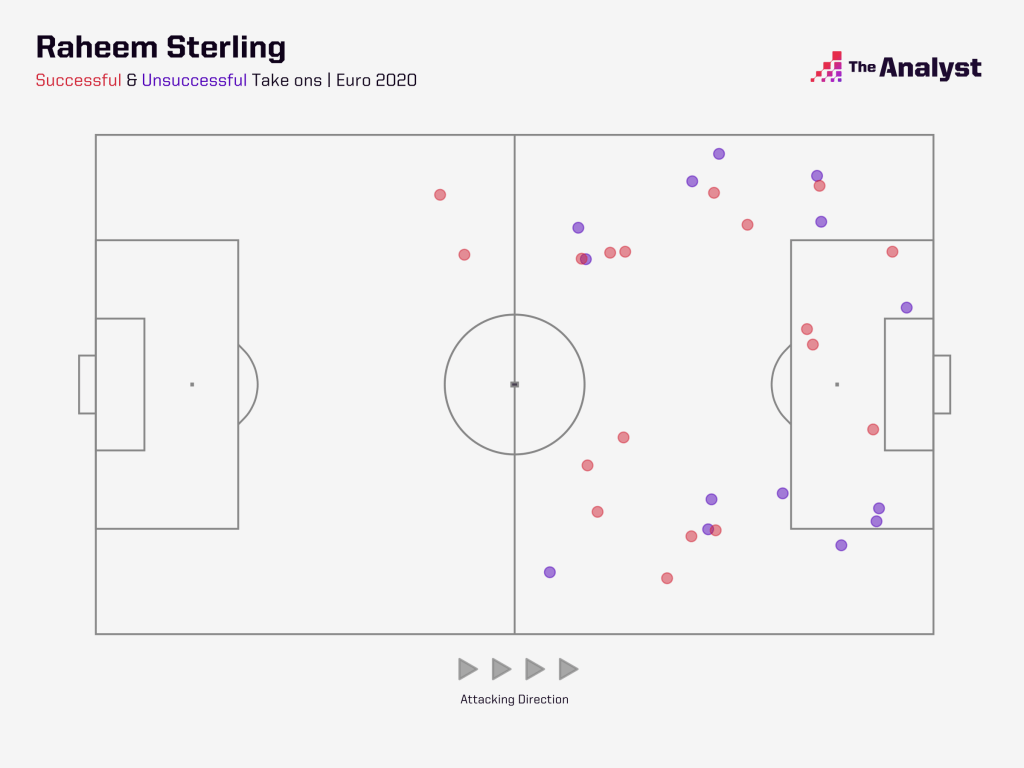
The City winger will be relishing the opportunity of running against the old veterans at the heart of Italy’s defence.
On the flip side you’ve got Federico Chiesa. Chiesa wasn’t even starting when the tournament begun, but he has quickly become vital to Mancini’s side with some impressive performances. His goal again Spain was a treat, latching on to a loose ball before squaring up Eric Garcia and bending the ball delightfully pass Unai Simon. The goal underlined two dangerous facets to Cheisa’s play.
First is his potency with the ball at his feet. With exceptional close control and dribbling, Chiesa is able to ghost round players and create shooting opportunities for himself. Only his teammate Domenico Berardi has completed more carries – defined as a player moving the ball five metres or more – followed by a shot than Chiesa out of all players at Euro 2020.
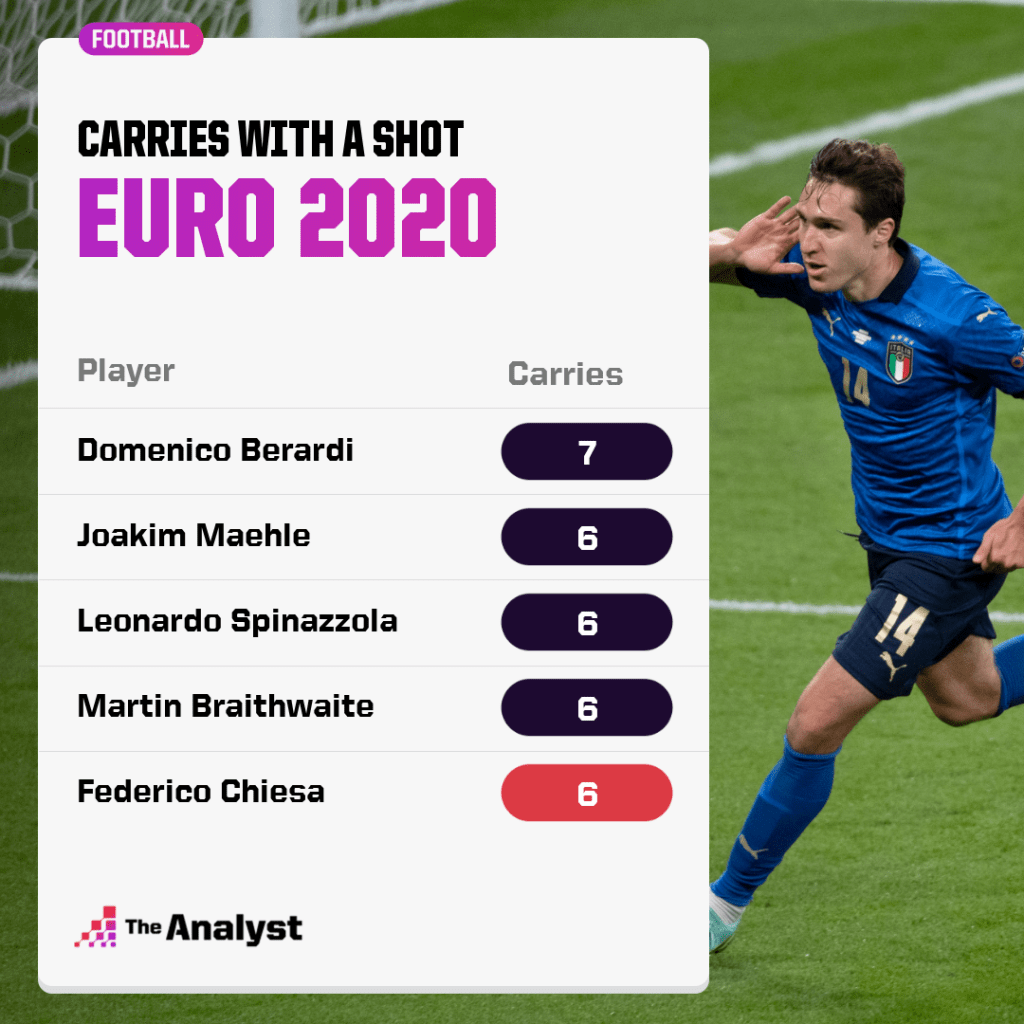
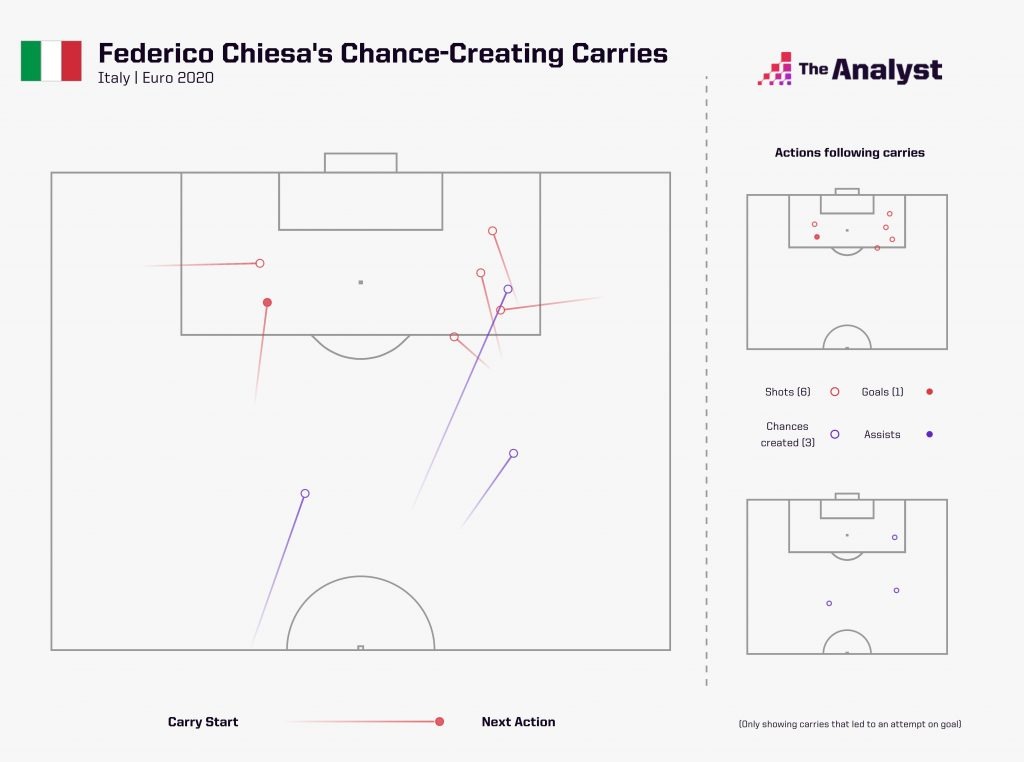
What the goal also showed was that Chiesa – together with Ciro Immobile – are this side’s ‘finishers’. The deadly sting in the tail.
As we’ve mentioned, Italy rely on their three-man midfield to progress to ball forward, with Jorginho and Verratti a hub of build-up and creativity. They continuously recycle the ball, pulling the opposition around to create space for their front three. They then release the likes of Chiesa to land the killer blow.
Only three players, two of whom have played significantly more minutes than Chiesa, have registered more direct shot involvements in Euro 2020. That’s defined as where a player’s only role in a passage of play is to take the final shot.
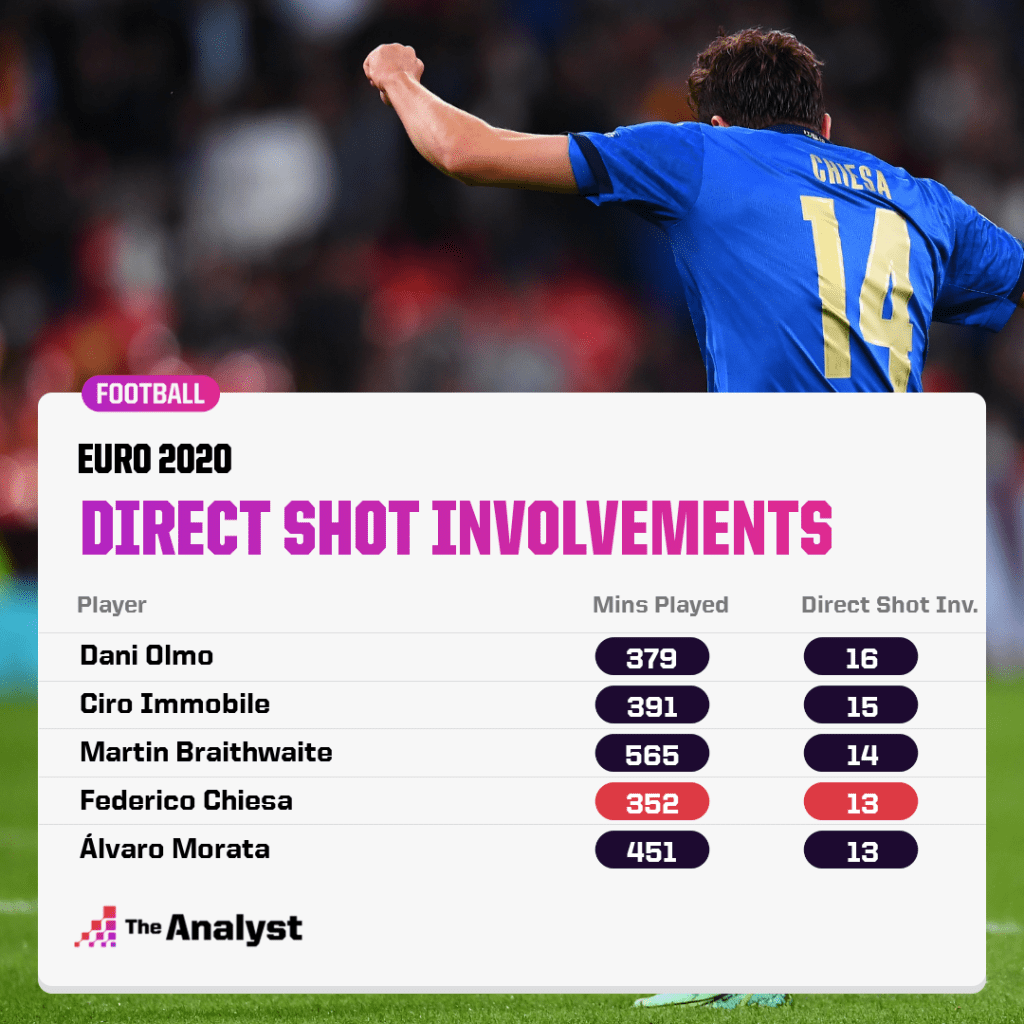
If Chiesa starts on the right of a front three like he did against Spain, then Luke Shaw and Harry Maguire will need to jump on any loose balls around the penalty area and also defend for their lives in any one v. one match ups.
Enjoy this? Subscribe to our mailing list to get exclusive content.
Design by Matt Sisneros.
